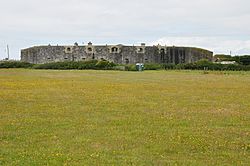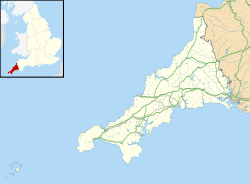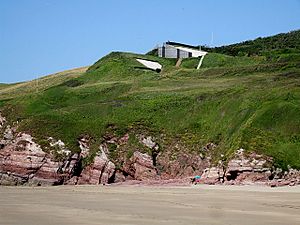Tregantle Fort facts for kids
Tregantle Fort is a historic building in south east Cornwall. It is one of many forts built around Plymouth. These forts were created to protect the area. They were built when Lord Palmerston was the Prime Minister. The main goal was to stop the French from attacking naval bases. These bases were important for ships along the English Channel coast.
Contents
Building Tregantle Fort
The design for Tregantle Fort was first made by Captain William Crossman. Later, Captain Edmund Frederick Du Cane made some changes. Building the fort started in 1859. It was finished in 1865.
Guns and Soldiers at the Fort
When it was first designed, the fort could hold 35 large guns. By 1893, it had five RBL 7 inch Armstrong guns. It also had nineteen RML 64-pounder guns. There were also some 32 Pounder Smooth Bore Breech Loading (SBBL) guns.
The fort was also built with rooms for soldiers. These rooms were called casemates. They could house up to 2,000 men. However, usually far fewer soldiers lived there. For example, in 1882, only six gunners were based at the fort.
Training and Use Over Time
In the early 1900s, Tregantle Fort became a headquarters for an infantry group. It had 14 officers and 423 other soldiers. From 1903, it was used for rifle training. The rifle ranges at Tregantle are well-known. They slope steeply down towards the sea. These ranges are still used today. Soldiers from HMS Raleigh often train there. HMS Raleigh is a naval training base.
Tregantle Fort was empty after World War I. Then, in 1938, it was used by the Territorial Army. They used it as a school for air defence. During World War II, it was first used as an Army Gas School. From 1942, it became a place for US Army soldiers to live.
Since 1945, the fort and the nearby cliffs and beach have been used by the British Armed Forces. It is now part of the Defence Estate. It is used for Royal Marine training. Special Royal Naval teams also use it. These teams work on EW, which means electronic warfare. They monitor ship communications in the area. They also send out special coded messages. Naval warships then try to decode these messages at sea. This is part of their ongoing training.
Tregantle Down High-Angle Battery
A short distance southeast of Tregantle Fort, another battery was built in the 1890s. This was called the Tregantle Down high-angle battery. It had four 9-inch muzzle-loading guns. These guns were on "high-angle" mountings. This meant they could fire shells in a high, curving path. The goal was to hit and break through the decks of enemy ships more easily. Even though the guns are gone now, you can still see where the battery was from aerial photos.





